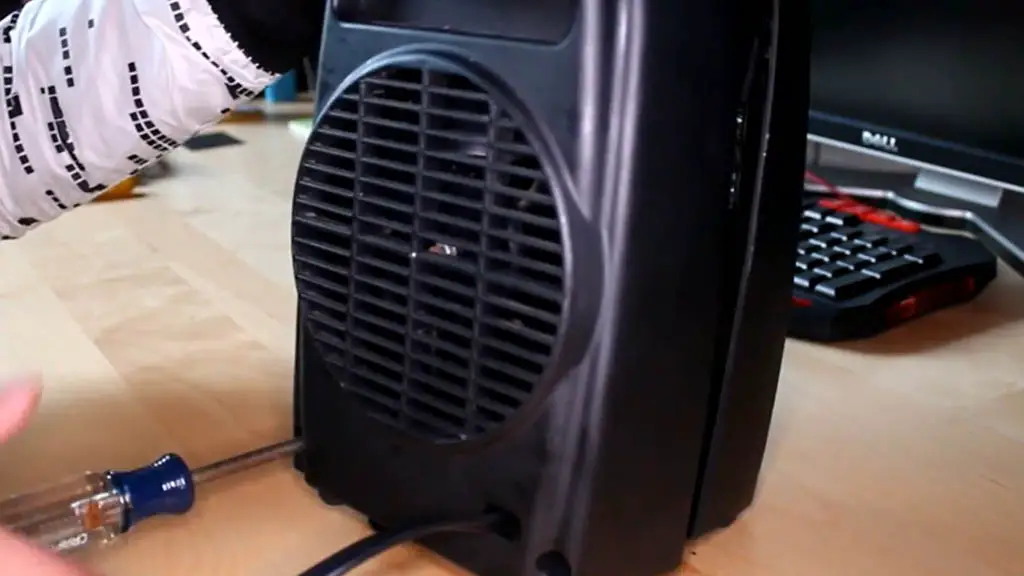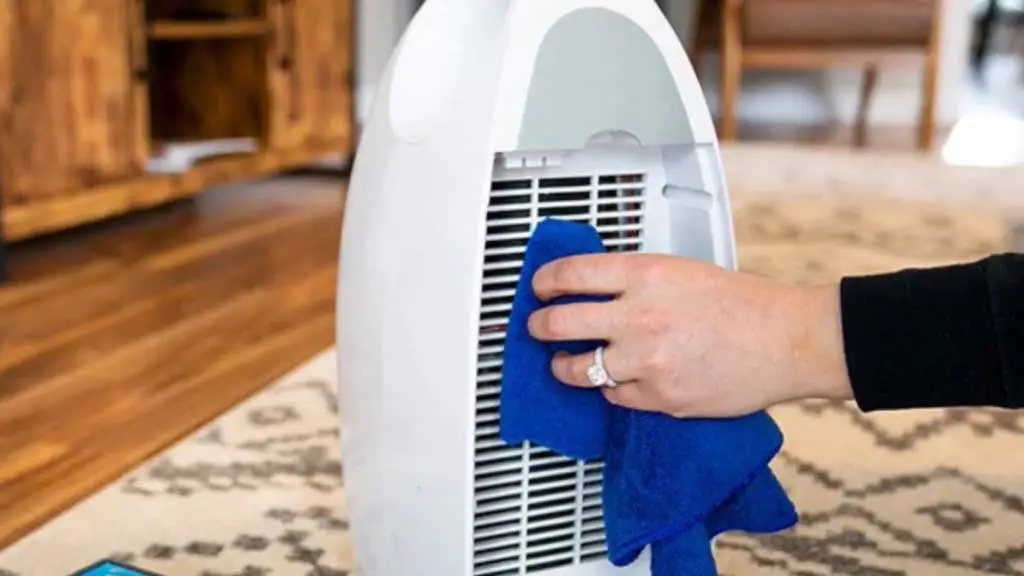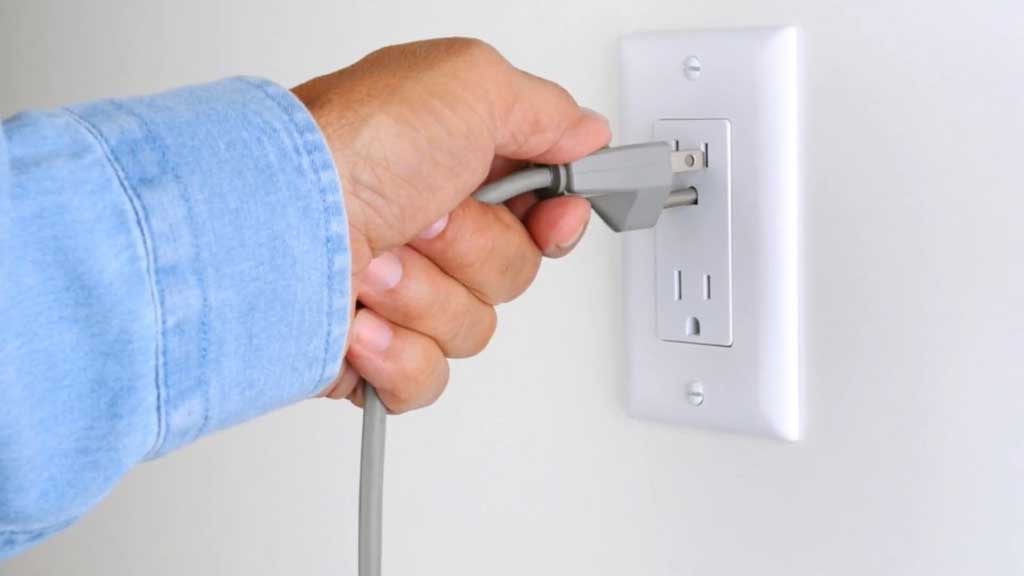Finding out that your Comfort Zone heater is making noise can drive you crazy. The most common causes behind it are:
- A loose fan blade nut.
- A misaligned motor.
- Dust or pet hair buildup.
- Worn-out motor bearings.
- Electrical interference.

But don’t worry. I’ll walk you through exactly how to identify and fix each of these problems. I’ve had to deal with this myself, and I’ll show you how to get your heater running quietly again. Let’s get started!
Comfort Zone Heater Making Noise
Here are the main reasons behind your Comfort Zone heater making noise when running it:
1. Loose Fan Blade Nut
If you’re using a new heater and find your Comfort Zone heater not working, this could be the issue. The truth is that these heaters aren’t the most durable in the world. As they’re not meant to last very long, the parts aren’t always tight and can become loose during shipping.
It’s possible that the fan blade nut got loose in transportation and caused the unwanted noise. It should be even more evident when you make the comfort zone heater settings higher. The intensity of the sound depends on the heater’s angle or how securely it’s mounted.
Solution:
Thankfully, this issue has a very simple fix. All you have to do is tighten the loose nut, and the fan should stop making the noise. Here’s how you can go about it:
- Turn off the heater, unplug it, and let it cool down.
- Take a Phillips head screwdriver and use it to carefully remove the front panel.
- Locate the central nut securing the fan blade to the motor shaft.
- Use pliers or a socket wrench to gently but firmly tighten the nut. (Make sure you don’t over-tighten or damage the plastic fan.)
- Put the heater back together.
When you’re done reassembling the heater, run it through another test and see if that fixes the issue. If your problem is solved, congratulations. If not, then keep on diagnosing.
Well, one more thing, in case you face any fan-related issues like the Comfort Zone heater fan not working properly you can check out my simple solution guide that is linked here.
2. Misaligned Motor
You’ll often hear your Comfort Zone heater making a screeching noise if the motor is out of alignment. It’s not a good state to leave the heater in. Because doing it can lead to the heater burning out completely in the long run.
Solution:
But the good news is that you can easily fix this by realigning the motor. Okay, easy may not be the right word for it. But if you have about half an hour to spare and the right tools available, you can fix this by yourself:
Step 01 – Open the Heater and Access the Motor
Start by unplugging the Comfort Zone heater. Let it cool down, and then start undoing the four screws to get access to the internal parts of the heater. Apply decent pressure when you remove the screws to make sure you don’t strip them. Then, you should be able to remove the front panel of the heater.

Once that’s done, remove the screws that hold the heater assembly in place. You should be able to glide the top control switch. Do this gently. Make sure you don’t pull or damage any of the wires.
Use a pair of pliers to remove the fan’s center mounting nut. Then, pull the fan firmly to remove it from the motor. Then, you’ll see two motor retainer screws. Gently loosen them about one full rotation.
Step 2 – Realign and Test the Motor
Now, it’s time for you to push down the motor bracket. As you do that, adjust the motor by hand. The purpose of this is for you to make sure that it spins freely and doesn’t make any scraping sound.
Before doing the next thing, double-check that the heater selector is turned to the “Fan” setting. Otherwise, there is the risk of burns or electric shocks. Then, turn the thermostat fully clockwise.
The safety switch on the bottom of the heater shouldn’t be pressed. Wear protective leather gloves and plug in the heater. Normally, the safety switch is designed to turn off the heater if it tips over. But we can also use it as a button to check the fan.
Press the safety switch for a short amount of time to ensure that the motor can spin. Keep tightening the motor screws while you adjust the alignment by hand, making sure that it spins freely. You don’t have to be perfect when you do this.
A small rattling sound is fine, as it’ll be masked out later. Make sure your fingers are at a good distance away from the motor when you spin it. Turn the heater case up so that the safety switch is pressed and the motor turns on.
With the motor running, tighten the retaining screws until it becomes smooth and quiet. The perfect balance is the key here. If the screws are too tight, the motor won’t be able to move and hence, not run. If they’re too loose, you’ll hear the screeching noise.
Step 3 – Reassemble And Final Check
Then, turn the case back to the side so that the safety switch is not pressed anymore. The motor should turn off automatically when you do that. Align the fan properly to the motor axle and attach it. When you push the fan to attach it, only press the center of the fan and not the blades.
Once again, press the bottom safety switch for a short while to make sure that the fan runs quietly. If not, you have to go back and adjust it. But if it no longer makes any noise, you’re done. Just unplug it, reassemble the heater, and test it again.
If the sound is gone, you’ve solved the problem. But if you still find your Comfort Zone heater making noise when running, you have to keep on reading and try the other fixes.
3. Build-Up of Dust
Do you still find that your Comfort Zone heater is making noise at night? Another common and yet overlooked reason behind it is the buildup of dust. You may hear it intermittently or constantly. The sound is more like a grinding or whirring noise.
In some cases, it can become louder over time and cause more issues. The usual suspects behind the heater being dirty are pet hairs, cobwebs, dust bunnies, and other debris.
They’re especially bad for the heaters, like the Comfort Zone ones that have an internal fan. The fan pulls these dust particles from the surrounding area and collects them around the fan blades. It can also accumulate around the motor shaft and vents.
If you live in a home with pets or in garages with poor air quality, the buildup can be even worse. As it restricts the airflow, it stops the fan from spinning freely, causing the noise. But when you don’t do anything about this, it can lead to the heater not working at all.
Solution:
Now, here’s the good part for you. As problematic as the build-up of dust is, it’s one of the easiest things to fix with your heater. You should already know how to open up the heater casing from the last point. If you can do that, this will be a cakewalk for you.
After removing the casing, you can use a small vacuum, a can of compressed air, or a soft brush to gently clean the important components. I think these are the ones that you must clean:
- The fan blades
- The motor housing and shaft
- The air vents and internal walls

Make sure you are gentle when cleaning. If you damage the wires or the fan blades during the cleaning, it’ll do more harm than good. You can also use a damp microfiber cloth for the cleanup if the build-up of dust is too high.
If that solves the issue, you’re good to go. Otherwise, you have to move on to the next issue.
4. Worn-out Motor Bearings
Okay, you’ve cracked out the easier things to do. Are you still wondering why my Comfort Zone heater is making noise when I turn it on? The most likely reason behind it is that the motor bearings may have gone bad. In that case, no amount of cleaning will fix the issue for you.
A strong sign that you’re facing this issue is a persistent buzzing, humming, or rattling sound. The noise may be louder when you start the heater. It often continues as long as the fan is running.
The motor bearings support the rotating shaft in the heater. These bearings reduce friction and allow the fan to spin smoothly. However, as you continue to use the heater, these bearings can dry out.
With more time and extended heat exposure, they can also completely burn out. When that happens, the shaft begins to wobble and create the annoying sound we hate.
As the Comfort Zone space heaters aren’t really meant to last really long, this is a common issue in older heaters. Running the heater for a long period without rest can also cause this issue.
Solution:
Okay, here’s the thing—this problem isn’t an easy one to fix. The Comfort Zone heaters aren’t designed to be serviceable. You know how to align the motor correctly. You can use the knowledge from those steps to replace it.
But in reality, it’s really hard to find the right motor for your heater. It also may not make any financial sense to get the motor and put the effort into replacing it. A much better option is to replace the heater itself in most cases.
There’s one big caveat to that—and that’s if your heater is under warranty. If it has been less than 90 days since your purchase, Comfort Zone should sort you out. For the more expensive heaters, it may make sense to replace the heater. But for the majority of them, getting a new heater is the safest option.
5. Electrical Interference
One of the weirder Comfort Zone heater problems that a lot of people face, and you may also, is electrical interference. What I mean by that is that the sound may come from the other electrical components around the heater but not the heater itself.

It’s usually a low buzzing noise from the back of nearby electronics like a TV, monitor, or computer. It only happens when the other parts are in close proximity to the heater. It usually occurs when the space heater is running. When the heater is turned off, the sound also stops.
It’s called electromagnetic interference, or EMI. More commonly, it’s also known as dirty power. As Comfort Zone heaters draw a significant amount of current, they are also known to cause this issue.
When that happens, it can introduce electrical noise into the power lines. If the heater shares the same power circuit with the electronic components I just talked about, you could face this issue.
Solution:
The simple thing to do is just to use a different power circuit. It’s not a big issue, as it means that nothing is wrong with the heater or the other electrical components. When they stop sharing the same power circuit, things should turn back to normal.
If you’re using an extension cord shared with the other electrical components, I would also suggest you stop using it. Once you do all these fixes, I don’t think you should face any trouble in terms of noise coming from your heater.
FAQs
Can I use WD-40 or a lubricant on my Comfort Zone heater motor to stop the noise?
No, it’s not recommended. Most heater motors are sealed and not designed for lubrication. Spraying inside can cause electrical damage or fire hazards.
Is a little bit of noise normal for Comfort Zone space heaters?
Yes, a low rattling noise isn’t that uncommon, as these units have a tip-over switch. It’s a safety mechanism meant to turn off the heaters in dangerous situations.
How often should I clean my Comfort Zone heater to prevent noise issues?
You should clean your heater every 1–2 months during heavy use, especially if you have pets or use it in dusty environments like garages.
Why does the noise get louder when I set the heater to a higher temperature?
It’s obvious if you think about it—higher settings make the fan run faster. It amplifies the existing issues and makes the noise worse.
Will placing the heater on a soft surface reduce the noise?
It might dampen some vibrations, but it’s not a fix. You should still identify and resolve the internal cause of the noise to avoid any long-term damage to the heater.
Conclusion
If you find your Comfort Zone heater making noise, you don’t have to panic. Whether it’s a loose fan blade, dust buildup, or a worn-out motor bearing, these issues can be easily fixed. You just need a bit of time and patience.
Start with the simple things. Tighten loose parts, clean out dust, and check the motor alignment. If the noise still doesn’t go away, you’d have to replace the old heater with a new one.
Keep your heater clean and well-maintained to prevent these problems in the future. And if your Comfort Zone heater won’t turn on, I’ve written a full guide to help you fix that too. Feel free to check it out.

